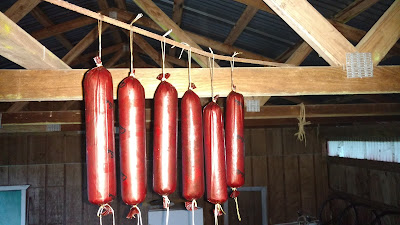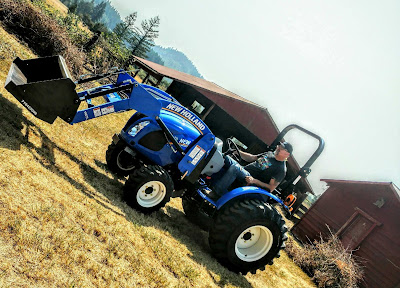It's been really dark these past few mornings while feeding the animals. I could hear the cows running at me but couldn't see them until they were right on me with their nose in the feed bucket before I could pour it into the feeder.
The shorter days makes it difficult to get things done around the farm as well. After coming home from work in the dark it's not easy to get motivated to do things in the dark. Looking forward to having more time to get things done, because there's a lot of things needing done!
We have finished a few things in the house, this past weekend we got some shelves up to store all of our food processing supplies. We're still adjusting things on these shelves and in the pantry. Having these shelves is a huge help and will make getting some of our processing done much easier since we won't have to dig through piles of boxes or run out to the shop where some of it was being stored. We've got plenty of room alongside of the shelves too for hoarding totes! We need more hoarding totes.
Yesterday Tori and Zach sanitized all the beer bottles we have and filled up a couple bottom shelves, now we're ready to bottle the hard cider we had fermenting and a batch of root beer. I'm also being pressured to make caramels since it's that time of year and it has become a tradition, can't break tradition so I'll probably need to make some caramels.
Thankfully I have a four day weekend, which gives me an extra day before Christmas gets here to finish up my last minute shopping. We're having a Christmas eve turkey dinner since the hams won't be ready until January. We bought an extra turkey at Thanksgiving because they're discounted and deep fried turkey is amazing.
Hopefully I'll be able to get all the other things needing to be finished. We have more flooring for the bedrooms, trees that need to be pruned, gravel that needs to be hauled in and spread, a barn that needs stalls for horses built, fencing repaired and a pasture divided for more rotation space, garden space prepped with some lime and mulch, general clean up, shop organized, fishing gear prepped, fishing trips taken, and all sorts of things that just need done!
Not that exciting of a post, I haven't been motivated lately to write and have a lot on my mind. These longer nights probably haven't helped with the mood or attitude, nor have the politics. I'm just looking forward to getting things ready for our horses and bringing them home!
Happy Winter Solstice to you all, hope you all have an exciting new year and best wishes!








































